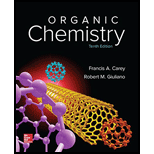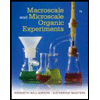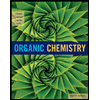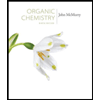
Organic Chemistry - Standalone book
10th Edition
ISBN: 9780073511214
Author: Francis A Carey Dr., Robert M. Giuliano
Publisher: McGraw-Hill Education
expand_more
expand_more
format_list_bulleted
Textbook Question
Chapter 16.5, Problem 5P
Give the structures, including stereochemistry, for the
Expert Solution & Answer
Want to see the full answer?
Check out a sample textbook solution
Students have asked these similar questions
Give the structural formula of A, B & C
Give the reagents and reaction conditions for the steps labelled v, x, w & y
Write a series of equations showing how to prepare cis-5-decene from acetylene and 1–bromobutane as the source of all its carbons, using any necessary organic or inorganic reagents.
Write equations in the synthetic direction for the preparation of 5,6-dicyanobicyclo[2.2.2]oct-2-ene from cyclohexanol and any necessary organic or inorganic reagents.
Chapter 16 Solutions
Organic Chemistry - Standalone book
Ch. 16.2 - Prob. 1PCh. 16.2 - Prob. 2PCh. 16.4 - Prob. 3PCh. 16.5 - Prob. 4PCh. 16.5 - Give the structures, including stereochemistry,...Ch. 16.5 - Prob. 6PCh. 16.7 - Prob. 7PCh. 16.8 - Prob. 8PCh. 16.8 - Prob. 9PCh. 16.9 - Predict the principal organic product of each of...
Ch. 16.9 - Prob. 11PCh. 16.10 - Prob. 12PCh. 16.11 - Prob. 13PCh. 16.12 - Prob. 14PCh. 16.12 - Prob. 15PCh. 16 - Write chemical equations, showing all necessary...Ch. 16 - Write chemical equations, showing all necessary...Ch. 16 - Which of the isomeric C5H12O alcohols can be...Ch. 16 - Prob. 19PCh. 16 - Write equations showing how 1-phenylethanol could...Ch. 16 - Write equations showing how 2-phenylethanol could...Ch. 16 - Prob. 22PCh. 16 - Show how each of the following compounds can be...Ch. 16 - Prob. 24PCh. 16 - Write the structure of the principal organic...Ch. 16 - Prob. 26PCh. 16 - Prob. 27PCh. 16 - Prob. 28PCh. 16 - Prob. 29PCh. 16 - Prob. 30PCh. 16 - (a) The cis isomer of 3-hexen-1-ol...Ch. 16 - Prob. 32PCh. 16 - Complete each of the following equations by...Ch. 16 - Prob. 34PCh. 16 - Prob. 35PCh. 16 - A diol (C8H18O2) does not react with periodic...Ch. 16 - Identify the compound C8H10O on the basis of its...Ch. 16 - dentify each of the following C4H10O isomers on...Ch. 16 - Prob. 39PCh. 16 - A compound C6H14O has the spectrum shown in Figure...Ch. 16 - Prob. 41DSPCh. 16 - Prob. 42DSPCh. 16 - Prob. 43DSPCh. 16 - Prob. 44DSPCh. 16 - Prob. 45DSPCh. 16 - Prob. 46DSPCh. 16 - Prob. 47DSP
Knowledge Booster
Learn more about
Need a deep-dive on the concept behind this application? Look no further. Learn more about this topic, chemistry and related others by exploring similar questions and additional content below.Similar questions
- What is the major monosubstitution product from the Friedel—Crafts reaction of benzene with 1 -chloro-2-methylpropane in the presence of AlCl3?arrow_forwardAn unknown hydrocarbon A with the formula C6H10 reacts with 1 molar equivalent of H2 over a palladium catalyst to give B C6H12 (Rxn 1). Hydrocarbon A also reacts with OsO4 to give the glycol C (Rxn 2). A gives 5-oxohexanal on ozonolysis (Rxn 3). Draw the structures of A, B, and C. Give the reactions.arrow_forwardList the alkenes that would be formed when 2-bromo-3-methylbutane is subjected to dehydrohalogenation with potassium ethoxide in ethanol and predict which one is the major product.arrow_forward
- Describe the product formed as a result of the reaction between cyclohexanone and 3-butene-2-one by also writing the mechanism of the reaction.arrow_forwardPredict the stereochemistry observed in the hydroboration, halogenation, and dihydrox- ylation reactions of alkenes.arrow_forwardWrite five reactions for preparing 2-Bromopropane and five properties of propynearrow_forward
- name the two diene products that could be obtained in the double-dehydration reaction of hexane-2,4-diol, and identify the major product.arrow_forwardDescribe a sequence of reactions by which meso-2,3-dibromobutane can be prepared from propyne.arrow_forwardExplain the Preparation of Dihalocarbenes ?arrow_forward
- In terms of steric effect and electron delocalization, explain: the solubility of acetylenic compound in many basesarrow_forward1. In the reactions involving the three isomeric alcohols with the formula C4H9OH, describewhat each of the following tests showed about reactivity of the -OH group and reactions of 1°,2°, and 3° alcohols.• the test with neutral KMnO4• the test with concentrated HCl2. Predict how the fourth alcohol with the formula C4H10O would react if tested with:• 0.01 M KMnO4• concentrated HCl at room temperatureExtend FurtherUse your observations of the solutions formed in the previous experiments and yourunderstanding of alcohols to complete a table like the one shown below. Research the meltingand boiling points to verify your answers.arrow_forwardHow many alkene products, including E, Z isomers, might be obtained by dehydration of 3-methyl-3-hexanol with aqueous sulfric acid?arrow_forward
arrow_back_ios
SEE MORE QUESTIONS
arrow_forward_ios
Recommended textbooks for you
 Macroscale and Microscale Organic ExperimentsChemistryISBN:9781305577190Author:Kenneth L. Williamson, Katherine M. MastersPublisher:Brooks Cole
Macroscale and Microscale Organic ExperimentsChemistryISBN:9781305577190Author:Kenneth L. Williamson, Katherine M. MastersPublisher:Brooks Cole Organic ChemistryChemistryISBN:9781305580350Author:William H. Brown, Brent L. Iverson, Eric Anslyn, Christopher S. FootePublisher:Cengage Learning
Organic ChemistryChemistryISBN:9781305580350Author:William H. Brown, Brent L. Iverson, Eric Anslyn, Christopher S. FootePublisher:Cengage Learning

Macroscale and Microscale Organic Experiments
Chemistry
ISBN:9781305577190
Author:Kenneth L. Williamson, Katherine M. Masters
Publisher:Brooks Cole

Organic Chemistry
Chemistry
ISBN:9781305580350
Author:William H. Brown, Brent L. Iverson, Eric Anslyn, Christopher S. Foote
Publisher:Cengage Learning

07 Physical Properties of Organic Compounds; Author: Mindset;https://www.youtube.com/watch?v=UjlSgwq4w6U;License: Standard YouTube License, CC-BY